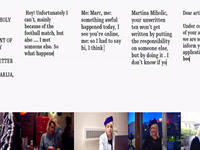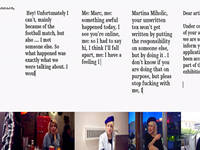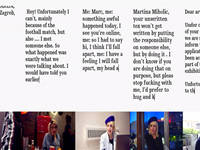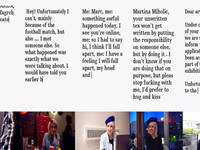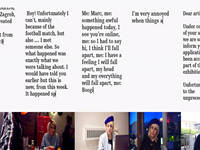Giant, Dense, Sunlit, Amorphous, Semitransparent, Pink Mass With a Thin Membrane which Measured 35°C, Was Called Failure and Wasn't Satisfied With Herself at the Time
Kuduz Class Show
SC Gallery, Zagreb, 2012
Video installation
Downloads: Text 1 Text 2 Text 3 Text 4 Text 5
It was ten in the morning and already it was 35 °C. We were supposed to meet at Gallery SC to talk about the show. On our way to Theater &td we could hear the clinking of bottles in someone’s bag, and Igor said: “Martina didn’t you have enough of those yesterday night?” To which I replied: “They’re not mine, they’re Tonka’s. Those are her jam jars.” Igor went on: “Yeah, and I’m Claude Jean Van Dam and this story of a friend carrying your ‘materials’ wouldn’t even work with the Pink Panther.”
The jars were in fact Tonka’s jam jars, but the fact was that I had had “more than enough” the night before, and in the three weeks before that as well. I remember hardly being able to sit in a chair at &td, drinking my fifth glass of water (it didn’t help), trying to form a coherent sentence. It didn’t work. My brain just kept dragging from one side to the other, like a pink bubblegum. But at least it was matched to a hair color, which appeared to be its only function at the time. Everyone laughed and said, ok, Martina, you’ll figure it out.
But something important happened that morning. What my brain was trying to articulate was a thought about the decision making process, about movement and stopping and the situations which influence them. And I’m not talking about situations which are agreeable and which we keep under control, but those which we would call an objectivisation of our own failure. I thought about the relationship between and our perception and understanding of success and failure, the ego, movements and pauses and an almost arrogant attitude of the culture we live in. The culture where everything that can’t be measured, which doesn’t grow, which isn’t potent, productive in an active, visible way is considered a pause, a break, a failure, something which needs to be buried deep within us, kept hidden from everyone, even ourselves, because it is a reflection of our weakness and impotence.
Looking back on those periods, it seems like I learned to appreciate the sense of failure in a weird way, but not masochistically, because as a rule these pauses would in the end spur on movement. Because after a pause nothing else can happen but movement.
Martina Miholic
KUDUZ ’S CLASS
Danijel Jaška, Jelena Kovačević, Igor Kuduz, Tonka Maleković, Ines Matijević, Martina Miholić, Maja Rožman
This exhibition which was intended as an homage to Professor Kuduz brings together seven authors from his class in the location where they held their first exhibitions and in which the Professor stood by their side from the preparation to the realization of their shows. Formally, this group wasn’t Kuduz’s last class but he’s considered them as particularly his (“my girls and Jaška”) and developed a close relationship with them which was mutually inspiring.
Being a part of Kuduz’s class is not merely a line in the biographies of these artists, signifying their affiliation to a certain group under the mentorship of the Professor and as a measure of quality and excellence but as a interconnectedness in many issues, above all the attitude towards the graphic arts, which are much more a matter of a specific world view and thinking through than a matter a technique. The role of the Professor in this case went beyond the usual paradigms of transferring knowledge and introducing students to the world of graphic arts, and arts in general. This sensibility towards paper as material and drawing as a medium has been conveyed by the Professor as a starting point which always needs to be rediscovered and built upon. The additional elements gathered from different spheres enrich the experiences and are reflected in the approach and the method in which compositions are structured. And it is precisely composition, rhythm and a sense of the dramatic that Professor Kuduz named as an alphabet of his artistic expression. He pointed out these experiences to his students, but without limiting them to his own though processes and criteria, but by allowing them to enter different fields in their search, curiosity and artistic development.
Printmaking as a technique and a medium was one of the expressions and starting points leading into other media and other techniques where the basics of printmaking were used as a tool for further development. An openness to different means of expression offered the opportunity for exploration, experimentation and the development of personal affinities. The attention that Professor Kuduz gave these young people and the freedom they experienced in his class gave them uplift in their creative and thinking processes, as well as implemented a strong dedication to work. An interest in his students and their professional development even after they graduated from the Academy, as well as the continued communication and meetings with him were encouraging and inspiring. The results of this exceptional mentoring work and a friendly and close relationship with the students are evident in their work through the years. Every single artist exhibiting in this show is an established author with significant artistic experience. Although the theme of the exhibition wasn’t predetermined the exhibited works have a common denominator in their precise execution that is evident in the smallest details, a playfulness that runs through these works, an interest in the current moment in consideration to the natural, urban and spiritual spaces and a connection in the manner of observation and assessment. The expression of the real and the imagined in different media through stories of growing up and creating new worlds gives the possibility of choice and looking through to the other side of the looking glass.
Ksenija Baronica


